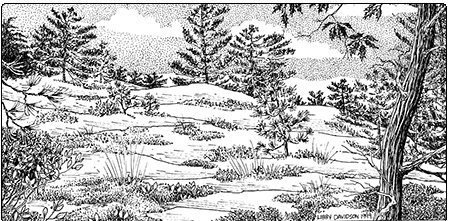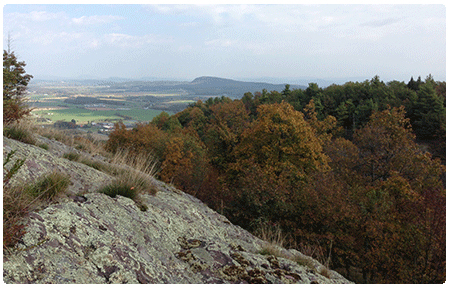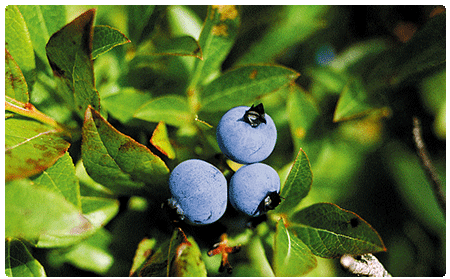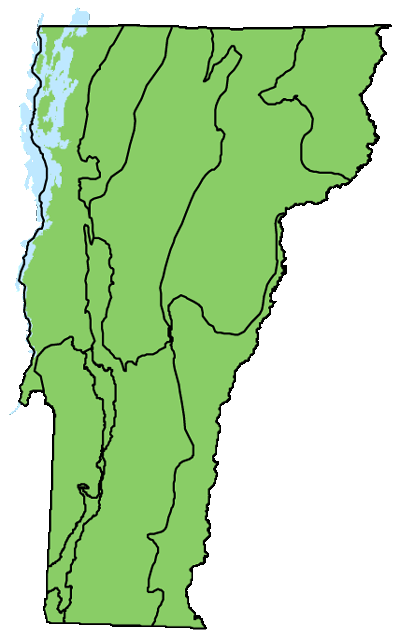Ecology and Physical Setting 
On low hilltops of granite, quartzite, sandstone, and schist below 2,000 feet elevation, one can find small exposures of acidic bedrock. On these Temperate Acidic Outcrops, soil is shallow, water is scarce, nutrients are limited, and summer heat can be intense. Most of these places are elevated above the general landscape and were therefore sheared clean when glaciers passed over them during the Pleistocene ice age. On many outcrops, soil has not developed since the retreat of the glaciers. Other outcrops may have accumulated some soil since the glaciers retreated but much of it was lost again when Europeans came to Vermont to farm, bringing their grazing animals with them. Sheep had a dramatic influence on hilltops, clearing and trampling the vegetation, and causing soil erosion and compaction, perhaps expanding the extent of some Temperate Acidic Outcrops. Looking to the future, extended summer droughts resulting from climate change could expand Temperate Acidic Outcrops even more.
The lone trees of Temperate Acidic Outcrops can be vulnerable to lightning strikes. These outcrops may therefore be maintained to some extent by occasional natural fires.
Vegetation

Temperate Acidic Outcrops, whether entirely natural or partly influenced by humans and their livestock, are stressful environments for plants. Trees are low and poorly formed. Shrubs, grasses, sedges, and other herbs grow in the cracks where soil has accumulated. Characteristic species include white pine, red oak, low sweet blueberry, late low blueberry, shadbushes, poverty grass, hairgrass, cow-wheat, wild columbine, and rock sandwort. Haircap moss and windswept moss can be abundant, forming large patches, and reindeer lichens are found throughout on the bare rock.
Wildlife Habitat
When Temperate Acidic Outcrops occur as a network of openings interspersed with stunted forest, they support species more typically found in shrubby habitats. The mix of stunted white pine and red oak with rocky openings provides nesting sites for eastern towhees and chipping sparrows. Chipping sparrows forage on open ground and build their nests in nearby shrubs and trees, frequently conifers. The Carolina andrena bee specializes in the pollen of blueberries and other heath shrubs. Eastern ratsnakes and other snakes use these sun-warmed outcrops for basking.
Related Communities

- Temperate Calcareous Outcrop is similar in vegetation and structure but is distinguished by species that indicate calcareous bedrock. Some of these species are northern white cedar, yellow oak, snowberry, ebony sedge, and Seneca snakeroot.
- Boreal Outcrop is similar in structure and vegetation but because of lower temperatures and greater atmospheric moisture, it has species such as red spruce, balsam fir, mountain holly, and brownish sedge.
- Dry Red Oak-White Pine Forest has very similar vegetation, but with more than 25% tree cover. It often includes outcrops.
- Dry Chestnut Oak Woodland may have areas of Temperate Acidic Outcrop within it but has regularly spaced trees and a more uniform cover of shrubs and herbs.
- Pitch Pine-Oak-Heath Rocky Summit, a woodland community with a canopy cover greater than 25 percent, can have areas of Temperate Acidic Outcrop within it.
- Red Cedar Woodland often interfingers with open outcrops.
- Red Pine Forest often has areas of Temperate Acidic Outcrop within it and near it.
Conservation Status and Management Considerations
Good examples of this community can be found throughout Vermont. The greatest threats are hiker trampling and the construction of communication towers.
Distribution/Abundance
This is a common community type in Vermont at lower elevations and in the warmer regions of the state. Most examples are quite small. Similar communities are found throughout the northeast.
Characteristic Plants
Trees
White pine – Pinus strobus
Red oak – Quercus rubra
Red maple – Acer rubrum
Paper birch – Betula papyrifera
Gray birch – Betula populifolia
Pitch pine – Pinus rigida
Shrubs
Low sweet blueberry – Vaccinium angustifolium
Late low blueberry – Vaccinium pallidum
Bush-honeysuckle – Diervilla lonicera
Black huckleberry – Gaylussacia baccata
Shadbush – Amelanchier spp.
Herbs
Poverty grass – Danthonia spicata
Hairgrass – Deschampsia flexuosa
Cow-wheat – Melampyrum lineare
Bastard toadflax – Comandra umbellata
Field pussytoes – Antennaria neglecta
Little bluestem – Schizachyrium scoparium
Wild columbine – Aquilegia canadensis
Bristly sarsaparilla – Aralia hispida
Silverrod – Solidago bicolor
Pale corydalis – Capnoides sempervirens
Common pinweed – Lechea intermedia
Depauperate panic grass – Dichanthelium depauperatum
Pilewort – Erechtites hieraciifolius
Rock sandwort – Minuartia michauxii
Rusty woodsia – Woodsia ilvensis
Bryophytes and Lichens
Bristly haircap moss – Polytrichum piliferum
Juniper haircap moss – Polytrichum juniperinum
Windswept moss – Dicranum flagellare
Windswept moss – Dicranum scoparium
Windswept moss – Dicranum montanum
Moss – Ptychostomum creberrimum
Liverwort – Ptilidium pulcherrimum
Reindeer lichen – Cladonia/Cladina spp.
Non-native Plants
Sheep sorrel – Rumex acetosella
Canada bluegrass – Poa compressa
Rare and Uncommon Plants
Douglas’s knotweed – Polygonum douglasii
Dwarf chinquapin oak – Quercus prinoides
Rand’s mountain goldenrod – Solidago randii
Rock spike-moss – Selaginella rupestris
Mountain spleenwort – Asplenium montanum
Smooth false-foxglove – Aureolaria flava var. flava
Annual false-foxglove – Aureolaria pedicularia
Clustered sedge – Carex cumulata
Nodding chickweed – Cerastium nutans
Fogg’s goosefoot – Chenopodium foggii
Canada frostweed – Crocanthemum canadense
Longleaf bluet – Houstonia longifolia
Forked chickweed – Paronychia canadensis
Slender mountain rice – Piptatheropsis pungens
Greene’s rush – Juncus greenei
Associated Animals
DeKay’s brownsnake – Storeria dekayi
Eastern towhee – Pipilo erythrophthalmus
Chipping sparrow – Spizella passerina
Carolina andrena bee – Andrena carolina
Rare and Uncommon Animals
Eastern ratsnake – Pantherophis alleghaniensis
Columbine duskywing – Erynnis lucilius
Places to Visit
Libby’s Look, Bolton, Preston Pond Conservation Area, Town of Bolton
Snake Mountain, Addison, Snake Mountain Wildlife Management Area, Vermont Fish and Wildlife Department
Haystack Mountain, Pawlet, Friends of Haystack
Black Mountain Natural Area, Dummerston, The Nature Conservancy
Jamaica State Park, Jamaica, Vermont Department of Forests, Parks, and Recreation
